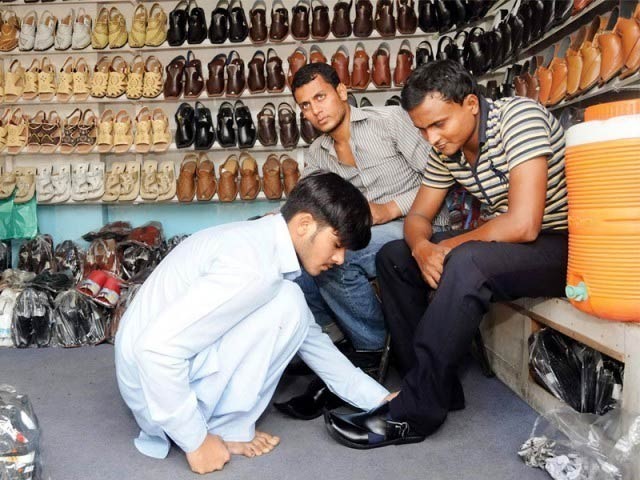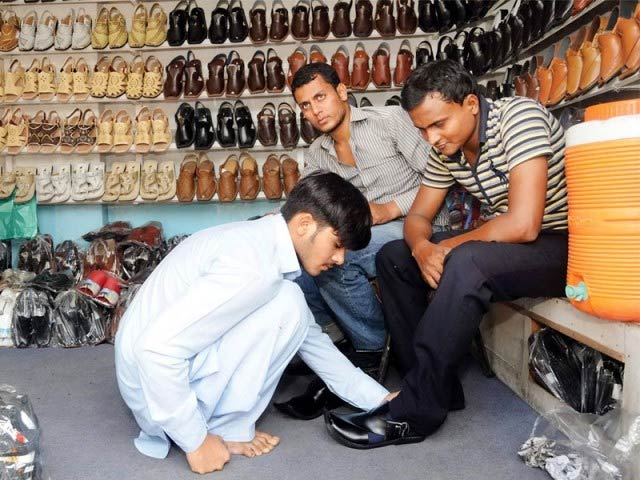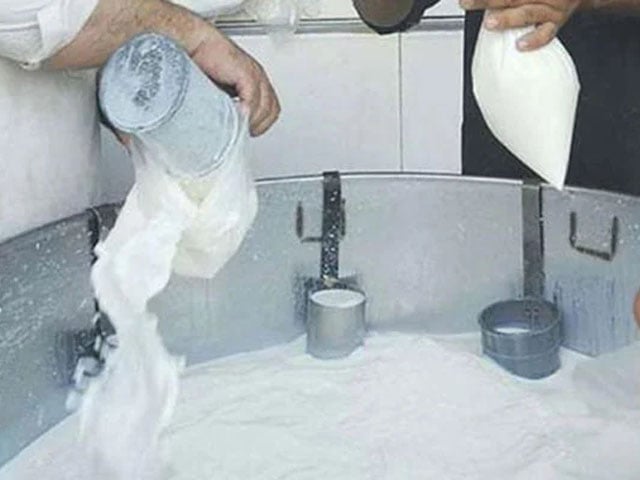
Buying new clothes, shoes and slippers is beyond the reach of the middle class and the poor, urban families fill their pockets or do Eid shopping. Photo: File
Due to rising inflation and reduced purchasing power, the attention of the citizens is focused on buying cheap Pizaras, Chappals and shoes which cost Rs 1000 or less.
In Karachi, the trend of purchasing different types of slippers and shoes has decreased by 60%, due to inflation and reduced purchasing power, the preference of ordinary citizens is to purchase cheap slippers and shoes, according to shoe and slippers sellers and buyers. Buying new clothes, shoes and slippers is becoming beyond the reach of the middle class and the poor.
Citizens can first feed themselves and their families and then do Eid shopping, waiting for customers to sell cheap slippers and shoes. Inflation has made buyers disappear from the market.
Due to inflation, the sale of slippers, sports and shoes decreased
Akram, a shopkeeper who manufactures slippers, said that due to the bad economic conditions, increasing inflation and affecting the purchasing power, the sale of different types of Peshawari slippers, Khedi cut shoes and other types of Kola Puri Nagra slippers and khass has decreased by 60%. Citizens tend to buy old and used shoes instead of buying new slippers and shoes.
With the stoppage of imports, the stock of Linda’s slippers and shoes has also become limited, so their prices have also increased by 60 to 70 percent. are completely ineffective.
He said that the preference of the citizens is focused on buying low-cost slippers and shoes with prices of 1000 rupees or less. Shopping for slippers and shoes.
80% less tendency to make slippers and shoes by measuring
Abbas Ahmed, a chappal trader, said that the trend of purchasing Peshawari chappal, Khedrian, Kohati chappal, Balochi chappal, Multani and Lahori khase and other types of chappals and shoes has decreased among the citizens. There has been a reduction of 80%.
The production of Peshawari chappal has become 200% more expensive in terms of chemicals and materials
Shehbaz Khan, a merchant who manufactures Peshawari slippers in Karachi, said that two types of leather are available in Pakistan at present, in which cheap leather is available at 120 rupees per foot and quality leather at 2150 rupees per foot. It has become 100% more expensive, local chemicals and materials are now being used in the manufacture of slippers and the prices have also increased by 200%.
As cobbler polishing became expensive, citizens started polishing their own shoes at home
Abbas Ahmad said that due to the high cost of polishing, citizens are now polishing their shoes at home, because now the cobbler charges 50 rupees per pair of shoes. The slippers are bought for Rs.800.
The working class and the poor buy rubber and nylon slippers and shoes
Akram said that the working class and the poor buy slippers and shoes made of rubber and nylon of different types, which are available at prices between Rs 200 and Rs 400.
The demand for cut shoes increased in the bazaars and markets
Shakeel Ahmed said that at present there is a high demand for cut shoes in the market, men, youth and children are buying cut shoes with different types of quality and design.
180 designs of peshawari slippers available in the market
Shahbaz Khan, the merchant of Peshawar slippers, said that there are different types of Peshawar slippers, including Peshawar captain Zardari slippers, Peshawar Zalmi Markhor F. 180 designs of slippers are being sold in the market, besides Multan and Lahori Khase Nagra Kola Puri and more than 50 types of slippers of different cut shoes.
Trader Abbas Ahmed said that most of the slippers and kheeds in Karachi are manufactured in Banaras, Kemari, Landhi, Quaidabad and other areas, and various top brands of slippers are manufactured in Mardan, Charsadda, Abbottabad, Peshawar, and Iranian and Balochi design slippers in Lyari and are produced in the market.
There is a shortage of artisans making shoes and slippers, Shahbaz
Shahbaz Khan, a slipper trader, said that there has been a shortage of skilled artisans who produce Peshawari and high-end shoes and slippers because the new generation of these artisans are not interested in shoe and slipper manufacturing, ordinary shoes and slippers. Liaquatabad, New Karachi, Korangi and other suburbs are manufactured in cottage industries and these slipper artisans are paid 30% of the actual cost of the slipper. While a typical slipper and shoe artisan produces 8 to 10 pairs a day, shoe and slipper manufacturing is also done on contract during the season.
15 colors and designs of Peshawari slippers
Chappal shopkeeper Imran said that there are more than 15 colors and designs of different types of Peshawari chappals and khedis, the price of plain chappals ranges from 600 to 1500 rupees, which are made from resin. The price of different types of Peshawar slippers starts from Rs.2000 to Rs.8000.
The price of khass and kolapuri khass ranges from Rs 800 to Rs 2,500, Peshawari chappals of other quality including Nairobi Quetta wall and sheepskin are priced from Rs 3,000 to Rs 6,000, he said in posh areas. The same slippers are being sold at double the prices.
Shehbaz, a slipper trader, said that a large number of young people are preferring to wear rubber and various designs of pregnancy slipper slippers which are locally manufactured and worn with jeans and pants shirts, as slipper slippers are being imported. Closed hence the sale of locally manufactured sleeper slippers is high and these slippers are available from Rs.500 to Rs.3000.
The people who speak different languages in the city also have a different choice of slippers
Shakeel Ahmed, the designer of the chael, said that Karachi is a collection of different nationalities and languages, Pashto speakers like to wear Peshawari slippers designed by Zalmi and Kaptan and Shaheen Afridi, Urdu-speaking Kaptan slippers by Bharam Baz Chaut Gap civil design slippers. Being worn like this because the slippers of this design are light and stylish which are liked by the Urdu speaking youth.
He said that slippers of this design are called Bharm Baz slippers in the market, Akram, a slippers seller, said that people from Punjab usually like to wear Khedrian Khase and Mianwali slippers, Baloch Irani and Balochi style slippers. While those from interior Sindh prefer to wear Zardari brand and simple Peshawari slippers.
(function(d, s, id){
var js, fjs = d.getElementsByTagName(s)[0];
if (d.getElementById(id)) {return;}
js = d.createElement(s); js.id = id;
js.src = “//connect.facebook.net/en_US/sdk.js#xfbml=1&version=v2.3&appId=770767426360150”;
fjs.parentNode.insertBefore(js, fjs);
}(document, ‘script’, ‘facebook-jssdk’));
(function(d, s, id) {
var js, fjs = d.getElementsByTagName(s)[0];
if (d.getElementById(id)) return;
js = d.createElement(s); js.id = id;
js.src = “//connect.facebook.net/en_GB/sdk.js#xfbml=1&version=v2.7”;
fjs.parentNode.insertBefore(js, fjs);
}(document, ‘script’, ‘facebook-jssdk’));


